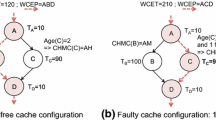Abstract
We present an analytical technique that uses fault injection data for estimating the coverage of concurrent error detection mechanisms in microprocessors. A major problem in such estimations is that the coverage depends on the program executed by the microprocessor as well as the input sequence to the program. We propose a method that predicts the error coverage for a specified input sequence based on fault injection data obtained for another input sequence. Our results show that post-injection analysis is a promising approach for reducing the cost of coverage estimation.
Similar content being viewed by others
References
A.M. Amendola, L. Impagliazzo, P. Marmo, and F Poli, “Experimental Evaluation of Computer-Based Railway Control Systems,” in Digest of Papers, Twenty-Seventh Annual Int. Symp. on Fault-Tolerant Computing, 1997, pp. 380–384.
T.F. Arnold, “The Concept of Coverage and Its Effects on the Reliability Model of a Repairable System,” IEEE Trans. Computers, vol. C-22, pp. 251–254, March 1973.
A. Benso, M. Rebaudengo, L. Impagliazzo, and P. Marmo, “Fault-List Collapsing for Fault-Injection Experiments,” in Proceedings Annual Reliability and Maintainability Symposium, 1998, pp. 383–388.
C. Constantinescu, “Using Multi-Stage and Stratified Sampling for Inferring Fault-Coverage Probabilities,” IEEE Trans. on Reliability, vol. 44, pp. 632–639, Dec. 1995.
E. Czeck and D. Siewiorek, “Observations on the Effects of Fault Manifestation as a Function ofWorkload,” IEEE Trans. on Computers, vol. 41, pp. 559–566, May 1992.
P. Folkesson and J. Karlsson, “ConsideringWorkload InputVariations in Error Coverage Estimation,” in Proc. Third European Dependable Computing Conf., 1999, pp. 171–188.
P. Gawkowski and J. Sosnowski, “Analyzing Fault Effects in Fault Insertion Experiments,” in Seventh Int. On-Line Testing Workshop, 2001, pp. 21–24.
J. Guthoff and V. Sieh, “Combining Software-Implemented and Simulation-Based Fault Injection into a Single Fault Injection Method,” in Digest of Papers, Twenty-Fifth Int. Symp. on Fault-Tolerant Computing, 1995, pp. 196–206.
J.R. Horgan, S. London, and M.R. Lyu, “Achieving Software Quality with Testing Coverage Measures,” IEEE Computer, vol. 27, pp. 60–69, Sept. 1994.
R.K. Iyer, “Experimental Evaluation,” in Special Issue of Proc. Twenty-Fifth Int. Symp. on Fault-Tolerant Computing, 1995, pp. 115–130.
E. Jenn, J. Arlat, M. Rimén, J. Ohlsson, and J. Karlsson, “Fault Injection into VHDL Models: The MEFISTO Tool,” in Proc. 24th Int. Symp. on Fault-Tolerant Computing, 1994, pp. 66–75.
J. Karlsson, P. Lidén, P. Dahlgren, R. Johansson, and U. Gunneflo, “Using Heavy-Ion Radiation to Validate Fault-Handling Mechanisms,” IEEE Micro, vol. 14, pp. 8–23, Feb. 1994.
G.C. Messenger, “Collection of Charge on Junction Nodes From Ion Tracks,” IEEE Trans. on Nuclear Science, vol. 29, pp. 2024–2031, Dec. 1982.
Saab Ericsson Space AB, Microprocessor Thor, Product Information, Sept. 1993.
T.K. Tsai, M.-C. Hsueh, H. Zhao, Z. Kalbarczyk, and R.K. Iyer, “Stress-Based and Path-Based Fault Injection,” IEEE Trans. on Computers, vol. 48, pp. 1183–1201, Nov. 1999.
Author information
Authors and Affiliations
Rights and permissions
About this article
Cite this article
Aidemark, J., Folkesson, P. & Karlsson, J. Path-Based Error Coverage Prediction. Journal of Electronic Testing 18, 343–349 (2002). https://doi.org/10.1023/A:1015095408146
Issue Date:
DOI: https://doi.org/10.1023/A:1015095408146




